| JAMES SHIRLEY'S TRIUMPH OF PEACE:
ANALYZING GREG'S NIGHTMARE
by
STEPHEN TABOR
| ||
§6. Quire B
A. PHASE I
The early phase of quire B presents one significant difficulty:
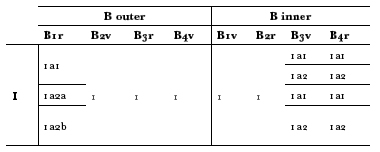 |
Only three pages show variant states in this phase. Those on B1r are:
1a1 heading wholly in italic
1a2 heading reset with characters' names in roman
- type relatively undamaged
- first letters of ll. 7 up and 9 up are damaged
We can be reasonably certain that this is the correct order because the
type
damage does not occur during state 1a1, and the reset heading follows the
normal
convention by giving proper names in a contrasting type style.
The variants in B3v-4r, in the backing forme, involve commas.
24
Neither
state is obviously the earlier, but the
direction of the change is less interesting at
this point than its confused
relationship with the outer forme: the early and late

distribution of surviving copies is as shown below:
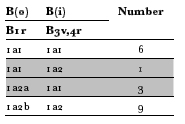 |
If, after printing the outer forme, the printer followed a normal turn of
the
heap of sheets that contained B1r, we would expect the changes on B3v-4r, in
the
backing forme, also to follow an orderly progression from early to late. We
saw
this pattern in quire A. In contrast, the distribution of states in Phase I of
quire
B shows a sort of "countercurrent eddy", indicated by the shaded cells
above.
It appears that a disorderly stack-turn took place. To understand this
concept,
first recall that a normal print run of a forme might produce several
hundred
sheets, yielding a thick pile of damp paper with the last-printed sheets
on top.
To preserve the same order and orientation of sheets going through the
press
on the perfecting run, the pile had to be inverted end-to-end. Since the
pile was
too bulky to turn as a unit, the workman had to transfer it in several
handfuls,
inverting each one onto the new stack.
Suppose instead that the workman carelessly transferred one handful of
sheets
straight across without turning it. This would produce a stratum of sheets
with
the printing facing the wrong way. We would expect the pressman, when
working
down the pile and finding this mistake, to utter a curse, turn the
affected sheets
to align with the others, and go on working. But he might also
utter a curse and
start picking up the sheets from the opposite end, using a
slightly different motion
to place them on the tympan. The pinholes—normally
positioned slightly
asymmetrically—would help prevent mishaps in perfecting, and
the pressman
might enjoy the little bit of variety until reaching the underlying
layer of correctly
oriented sheets. This seems to be what happened in Phase I of
quire B. Let us
use our sample of the nineteen copies of that phase to stand for
the entire first
printing of this gathering. The machining of the outer forme
(containing B1r)
produced a heap like the one on the left below, with the later
states on top.
If we now back up these partially garbled sheets with the inner forme
containing
B3v-4r, which begins with state 1a1 and switches to state 1a2 about
half-way
through, we get the observed distribution of variants (table 15).

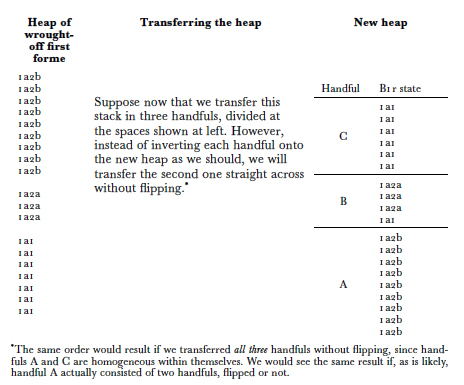 |
A stack turn with handful B transferred without flipping is the only
scenario
that yields the observed results if we assume the printer started the
perfecting
run at the top of the stack and worked his way straight through. Our
thought
experiment also shows that state iai of B3v-4r most likely came first. If
state 1a2
had been earlier, we would have to hypothesize a second turning of the
garbled
stack—this time correctly done—yielding the inverse of the first column
above.
The reader may verify that this does not yield the observed distribution of
states.
We cannot change the boundaries of group B without creating a conflict
with the
observed combinations, so that cohort must represent the survivors of a
manageable
number of sheets that the worker was comfortable picking up with
two
hands. It is tempting to extrapolate from our nineteen-copy sample to
estimate
the total number that were printed in Phase I. If group B represents one
"grab",
the total first printing of the quire might have contained four roughly
equal
handfuls of damp sheets, each of which in ToP
measured about 41 by 31 cm.
25
A
practical trial might provide an estimation of the edition size. However, it
proves
difficult to locate a source of poor-quality, lightweight, handmade paper
with

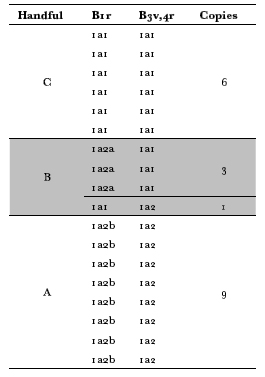 |
getting usable data from present-day fine printers regarding their paper-turning
habits. It turns out that there are a host of variables that make it impossible even
to approximate an upper limit on the edition size by this means.
It should make us slightly uncomfortable that B1r state 1a2b is
absolutely
coextensive with group A. The last handful (or more likely two) appears
to have
contained only that state, which occurs nowhere else; and state 1a2a is
found
only in handful B. If my analysis above is correct, and if further copies of
ToP
were to come to light, one of them might contain
B1r:1a2a combined with a
later state of B3v-4r.
B. QUIRE B, PHASES II-IV, OUTER FORME
The next phases of quire B are so complex that it is necessary to analyze the
two
formes separately.
After Phase I, three of the pages of B(o) were reset and one (B3r) was
reprinted
with a new skeleton. Phase II's only variants occur on B4v (in states
2a1 –3) in the
passage "ayre, ... with an artificiall bellowes coold". The last
word also appears

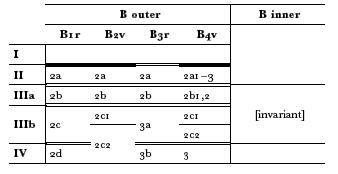 |
the variants probably result from a two-stage accidental loss of letters from the
end of the line. Frisket slip is not a suspect here because there are no intermediate
states—the letters are either completely present or completely lacking.
For Phase IIIa, all of the pages have new skeletons. Page B4v state 2b2,
found
uniquely in a copy at St. Catharine's College, Cambridge
(Z.59), presents
a problem because the page number has shifted horizontally.
However, the type
appears to be the same and the page is unchanged in other
respects, so reimposition
is not likely to be the cause. If looseness in the line
caused the shift, we
would also expect slightly different spacing among the three
characters of the
page number, but we do not see this either. It remains an
unexplained problem,
but a minor one.
In the discussion of quire A, I identified a point within Phase I at which
press-
work was interrupted, but the other formes of the book from that phase did
not
show a similar hiatus. Sub-Phases IIa and IIb were in effect separate
printings of
quire A, with both formes showing changes. Quire B is a slightly
different case.
Again, it appears that a more urgent job interrupted the printing,
this time during
Phase III of the outer forme. The delay was long enough that the
type-pages
were stripped and probably tied up. After the other job played through,
printing
of B(o) resumed with a new skeleton, including a new arrangement of
acorns on
B1r. (I have not been able to determine whether the direction lines were
reset as
well—they are closely similar.) These re-imposed copies constitute Phase
IIIb.
However, both of these impositions of the outer forme occur with identical
states
of the inner forme. The two sub-phases of the outer forme seem to have
gone
through a single perfecting run.
26
Apart from this one forme—and a couple of
other small variants
which I will discuss in §11–14—these five copies resemble
the twelve others from
Phase III.

The following corrections demonstrate that Phase IIIb indeed followed
Phase
IIIa:
 |
In Phase IV of this forme, a few things are of interest:
- On B1r, the page number wanders a bit horizontally over the 15th
pair
of acorns. - Likewise, on B2v, the stem of page number "4" can point to the first
letter
of "the" below, to the "o" in the preceding word, or anywhere in-between. - In this phase, B3r picks up the first three lines of text (in a new
setting)
from the following page, relieving some crowding on the latter. - On B4V, the four flush-right italic lines have been raided and are
reset in
smaller (pica) size. The two centered italic lines on the same page are unaffected,
perhaps because it was not worth the trouble to get at them. On this page also
the page number is horizontally unstable. This example of wandering, along with
items 1 and 2 above, are among many in ToP that demonstrate that lockups on
the press bed must have been much less rigid than Joseph Moxon's descriptions
would lead us to expect.
C. QUIRE B, PHASES II-III, INNER FORME
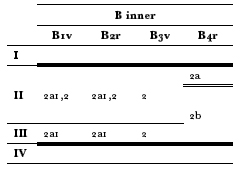 |
The inner forme of quire B is even more perplexing than the outer one.
Phase II
begins with a complete resetting of all four pages. Shortly afterward,

direction of the change from 2a to 2b is confirmed by a textual correction and
progressive damage to line 7 during state 2b. For only one page of a forme to
change its skeleton is puzzling enough. But it also occurs against a background
of changes to its forme-mates B1v-2r which do not develop in consistent directions.
These variants are:
B1v: The "V" beginning line 10 is more or less displaced downward, or is
entirely
absent. Where it is absent, the "D" from two lines down drifts up into
the vacant
space.
- B2r: 1. St. Catharine's College (Cambridge)
Z.55 shows a unique setting of
the page number. The number "3" comes from a different font than that found
elsewhere in the book, being rounded and with the upper loop noticeably smaller
than the lower. It is evenly spaced between undamaged parentheses. All the other
copies have the usual narrow "3" with loops about the same size, and one or
both of the page-number parentheses are either damaged or fouled with ink. This
number was apparently not locked up tight, and it can fall anywhere from close
to the left parenthesis to centered between the two. The direction line appears
to contain the same type as does the St. Catharine's copy. - In some exemplars, the right ends of lines 1 and/or 4 creep upwards
by
varying degrees. - The comma ending line 6 prints either normally or as a blob.
- A stray bit of metal resembling a hyphen may show in the empty
space
between lines 6 and 7 and below the "na" of "nature" in line 4.
A tabulation of these features shows some correlation among certain
manifestations
of variant 1 above (a bit of dirt on the right parenthesis at about
2 o'clock),
variant 2 (both lines displaced), and the blobby comma in variant 3.
But other
characteristics do not line up, either with each other or with the
amount of type
damage on B4r. Most of the features are of a transient nature and
could be
reversible: for instance, the wayward "V" on B1v could drift, fall out,
and be
replaced, so late copies might look like early ones. The loose page number
with
its parentheses could have fallen apart near the end of the run, and all
three types
could have been reset to produce the unique manifestation in the St. Catharine's
copy. The stray metal in variant 5 could have
been slightly raised in the forme
throughout this phase, but would print only when
sufficient pressure
Excessive attention to these details might not be either productive or
healthy,
but it is not so easy to dismiss the skeleton change on B4r early in
Phase II (the
transition from state 2a to 2b), mentioned above. Because there is
no evidence
of changes on the other three pages of the forme at that point, it
presents a challenge
to my theory that arbitrary page-number changes are signs of
work stop-
pages. It is another occurrence I will have to leave unexplained.
D. QUIRE B, PHASE IV, INNER FORME; QUIRE B RECAPITULATION
The final phase (IV) of forme B(i) shows a resetting of all the pages. For
no
obvious reason, the four-line roman-face stage direction on B3v beginning
"The
Gentleman ..." is now set in pica, one step smaller than the surrounding
text.

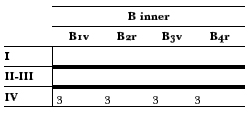 |
Combining all that we have discussed about both formes of quire B generates
table
20, which is puzzling in its fragmentation and necessarily evasive
about
correlations among certain states below a certain level of detail.
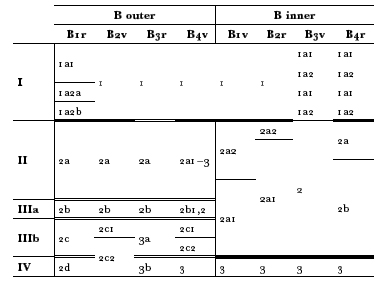 |
Nevertheless, it is possible to discern two events, initiating Phases II and
IV,
that clearly interrupted work on the entire quire. These resulted in the
resetting
or reimposition of almost all the pages. The outer forme underwent two
more
skeleton changes on its own, introducing Phases IIIa and IIIb.
What I have
called state 1a1 of B3v has "off throw" in l. 10; B4r ll. 16–17 read
"This
[man] with a face Philosophicall and beard / Hath with the study of
twenty yeares found out / A lampe ...". State 1a2 of both pages respectively have
"off, throw" and "This with a face Philosophicall
and beard, / Hath with the
study of twenty yeares, found out / A lampe ..."
| JAMES SHIRLEY'S TRIUMPH OF PEACE:
ANALYZING GREG'S NIGHTMARE
by
STEPHEN TABOR
| ||